Introduction and Testing Method & Test System Configuration
When I started writing my GeForce GTX Titan X review, I was packing my bags to prepare for NVIDIA's GPU Technology Conference in San Jose, California - but now I'm back from GTC 2015 with another Titan X in hand, and we're about to get some GM200 in SLI results that are sure to impress.

During GTC 2015, NVIDIA officially announced the GeForce GTX Titan X, which is powered by the full GM200 core. We went through this in our original review of the Titan X, where we have a super powerful video card that impressed us in every resolution possible. We even tested it with NVIDIA's 4K Surround, where we used three 4K monitors for a huge 6480x3840 resolution, thanks to Acer's XB280HK displays.
Even still, the Titan X was able to provide a playable 30FPS or so frame rate, but we're excited to see what two Titan X cards can do in 4K Surround. First, we'll see how they do in our usual tests, with 1080p, 1440p and 4K.
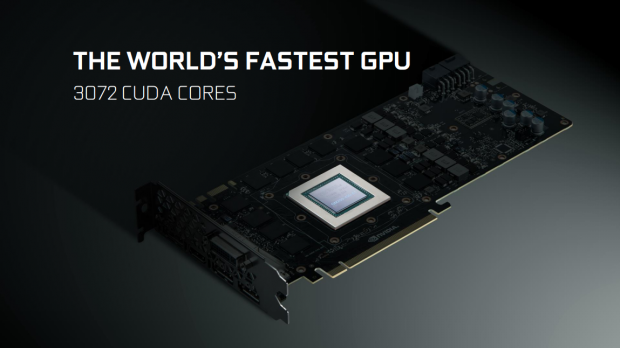
Titan X samples are hard to come by, so we're quite excited to have two of them in the TweakTown labs. We have a third one on its way, and a fourth is something we're going to be working on. It's still pretty unbelievable that we have this type of power right now on 28nm technology - incredible fast, but very efficient video cards with the possibilities really opening up with 4-way SLI and 4K and beyond.
NVIDIA were very kind to provide us with a second GTX Titan X, so we immediately began testing the Titan X in SLI as soon as I landed back from my GTC 2015 trip. It was quite an amazing sight, seeing two Titan X cards in SLI.
Testing Method
Because I'm just starting out reviewing GPUs, we're going to slowly evolve our benchmarking setup. I'm not going to dive into the deep end and start testing out real-time FPS, as this will hurt the quality of the reviews. Instead, I'd like to nail these initial reviews and then we can start doing real-time numbers of games like Far Cry 4, and Star Citizen. For now, I've played Battlefield 4 on a 64-player server to provide some real-world performance numbers.
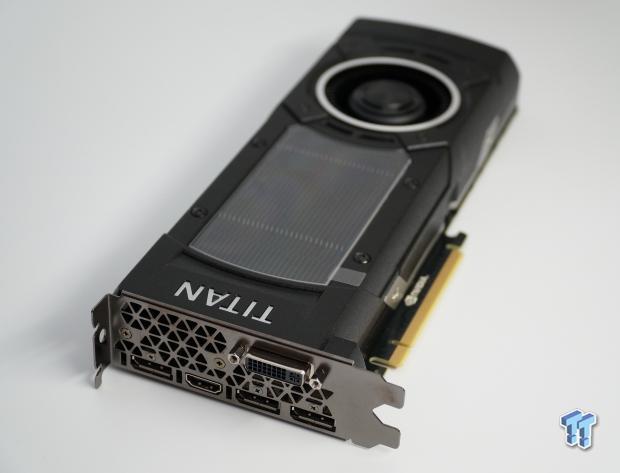
For now, I'm going to be using the same suite of benchmarks I've been using on my Tweakipedia articles, which uses a mix of synthetic benchmarks with Futuremark's 3DMark and Unigine Heaven. After that, we have a bunch of titles with built-in benchmarks (which does not represent actual in-game performance) but they are repeatable for you at home to gauge the performance of your PC or GPU.
Over time, I will be adding in new benchmarks and a new section that will concentrate solely on real-time gaming benchmarks. This will take more time per review, as I'll have to invest time into actually physically playing the games, but it'll be worth it in the long run. For now, let's get right into the synthetic benchmarks and see how this NVIDIA GeForce GTX Titan X performs in SLI.
Test System Configuration
We only recently built our new X99-powered system, something you can read about here. As for the detailed specifications, this is what we're running:
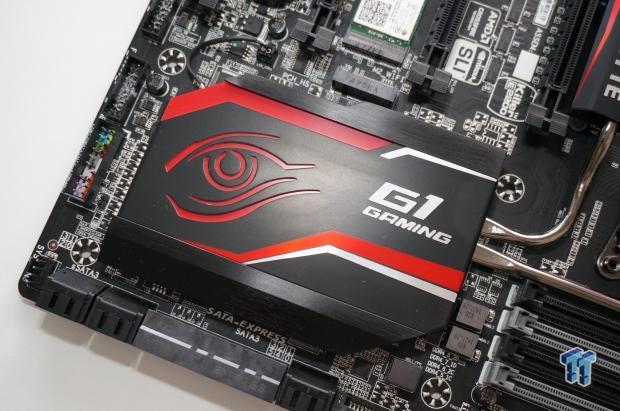
- CPU: Intel Core i7 5820K processor w/Corsair H110 cooler
- Motherboard: GIGABYTE X99 Gaming G1 Wi-Fi
- RAM: 16GB Corsair Vengeance 2666MHz DDR4
- Storage: 240GB SanDisk Extreme II and 480GB SanDisk Extreme II
- Chassis: Lian Li T60 Pit Stop
- PSU: Corsair AX1200i digital PSU
- Software: Windows 7 Ultimate x64
- Drivers: 347.88
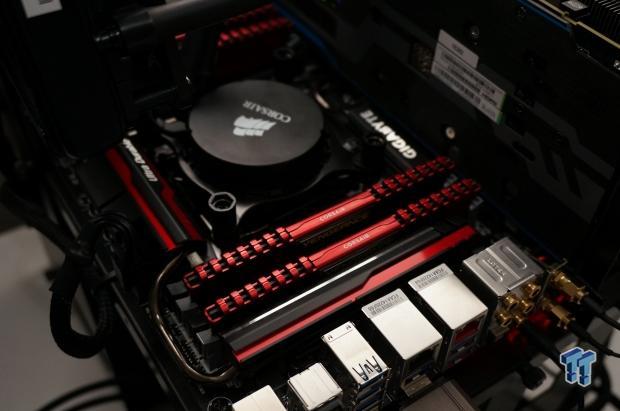
We're running the system at stock CPU speeds, which will provide more of a 'real-world' feel to our benchmarks. Sure, this isn't an i7-5960X at 5GHz, but what person is going to team up an incredibly expensive CPU with a mid-range GPU? Not many.
Our GPU tests are changing, shifting toward more of a real-world feel. But don't worry, we will be doing some crazy balls-to-the-wall tests that will see serious overclocks, Extreme Edition processors, and much more in the coming months. For the most part, we will be doing more real-world testing by teaming up the right processor with the right GPU in its price category.
Benchmarks - Synthetic (3DMark and Heaven)
3DMark Fire Strike - 1080p
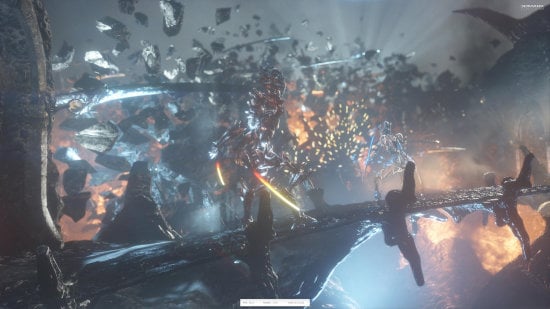
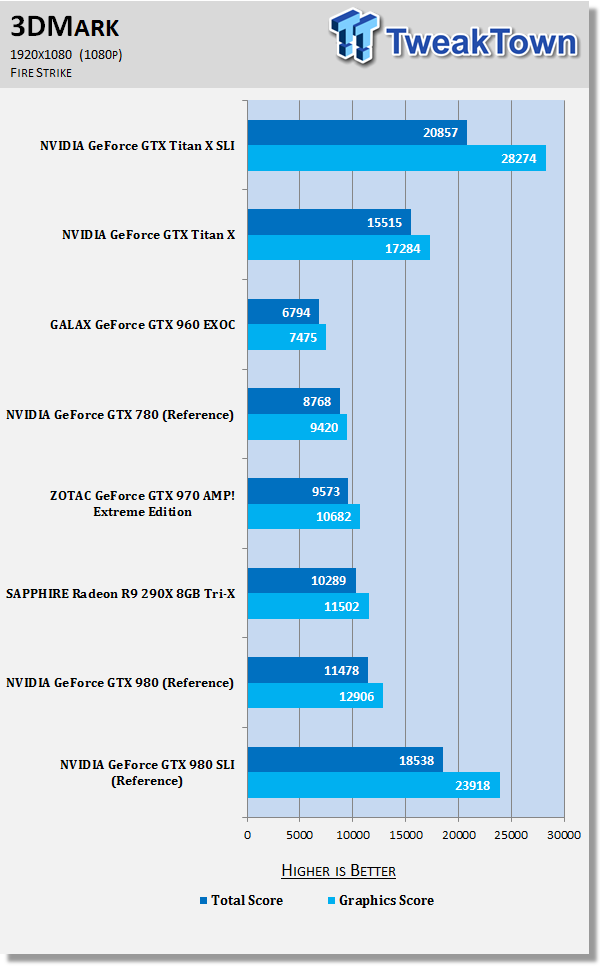
3DMark Fire Strike Extreme - 1440p
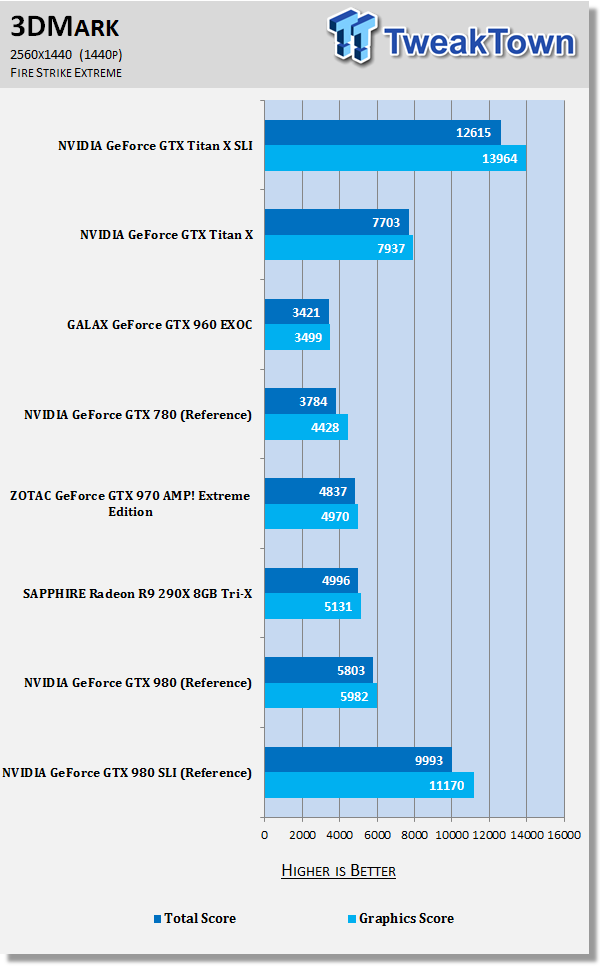
3DMark Fire Strike Ultra - 4K
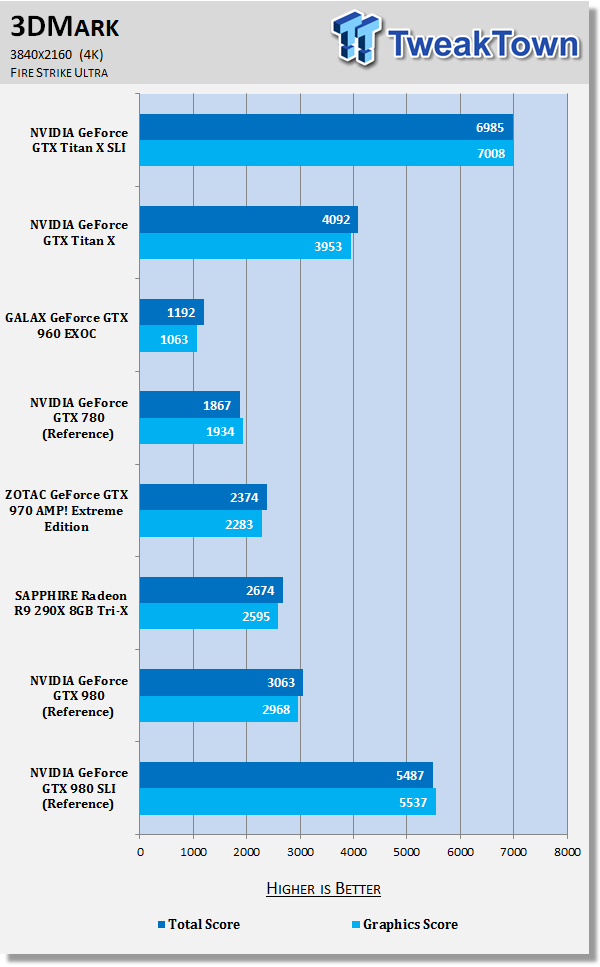
Heaven - 1080p

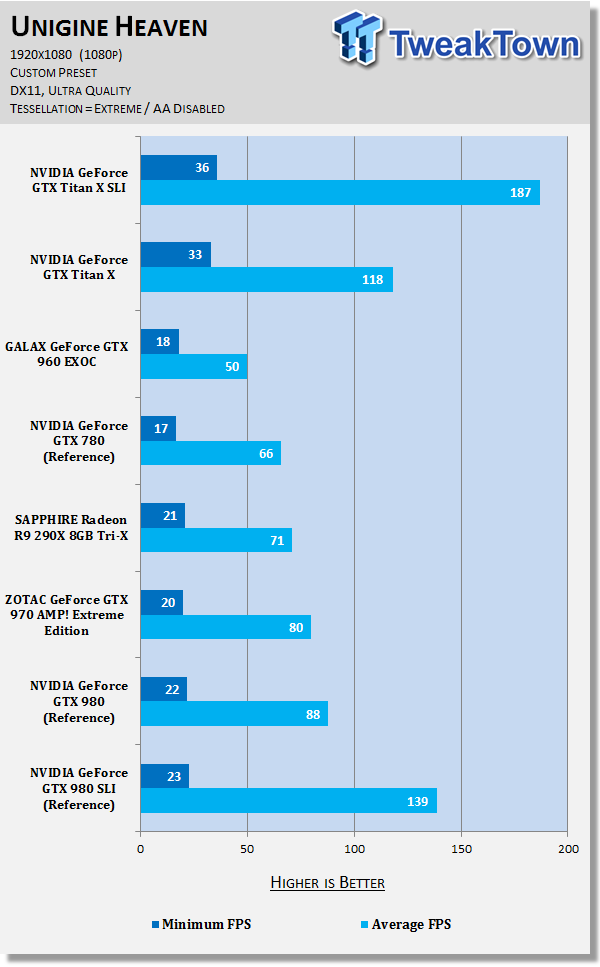
Heaven - 1440p
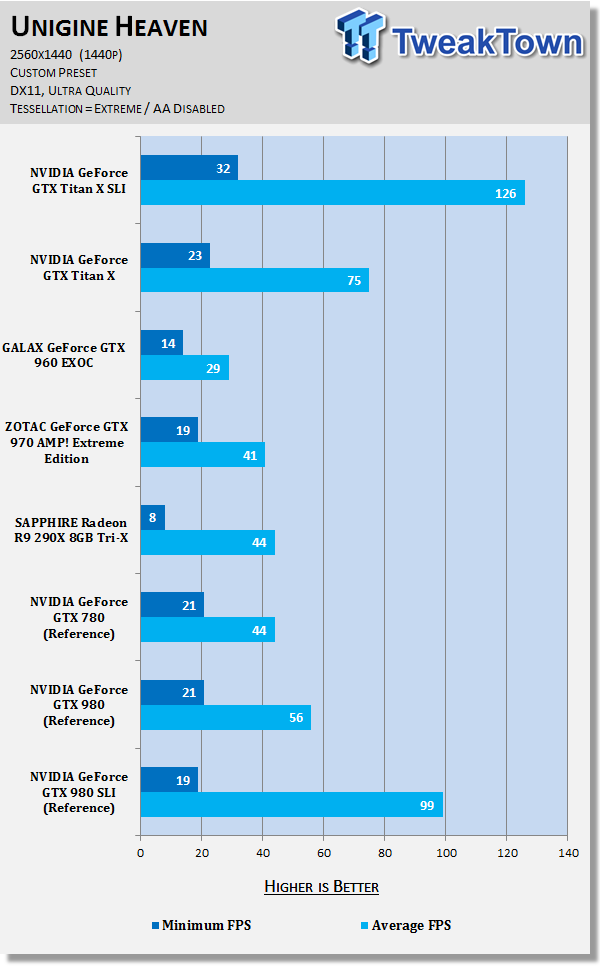
Heaven - 4K
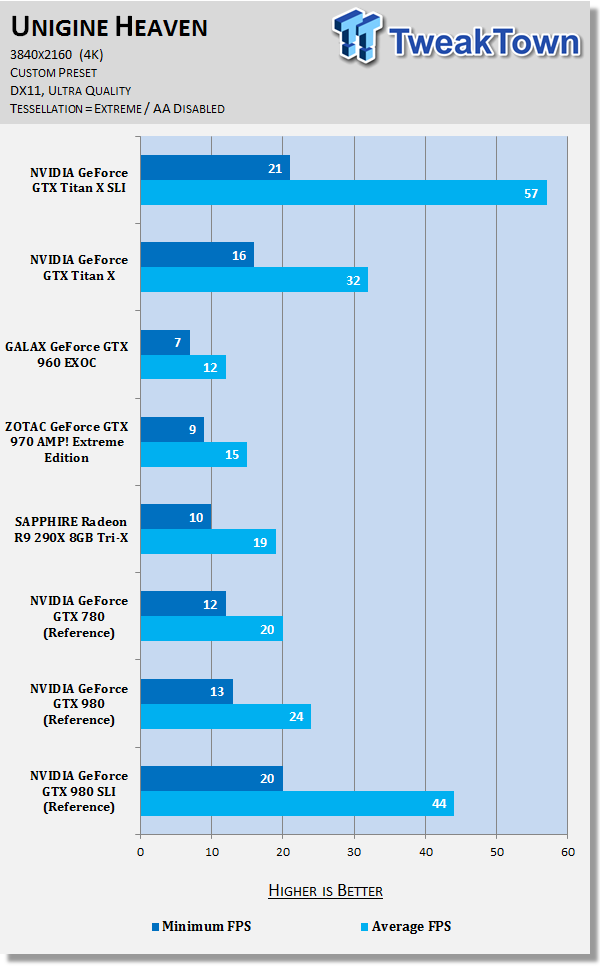
Starting with 3DMark in 1080p, we can see that the Titan X in SLI demolishes the single Titan X where we have the graphics score increasing by a huge 63%. At 1440p, that scores increases by 76%. At 4K, the Titan X SLI is 77% faster than the single Titan X.
Heaven provides the same type of increases, where at 1080p we have a 58% increase with the Titan X in SLI over the single Titan X. Jumping up to 2560x1440, the Titan X's in SLI beats the single Titan X by 68% while at 4K, the two GM200-powered cards beat the single GTX Titan X by a huge 78%.
Game Benchmarks (1080p)
Battlefield 4
This is one game that we did differently, as it does not feature a built-in benchmarking feature. When it comes to Battlefield 4, there are countless ways you can benchmark it. Some find a spot in the single player campaign which is easily repeatable, and use that. For our testing, we've chosen to use a 64-player online multiplayer server for real-time performance statistics.
We joined a 64-player map and played for five minutes using FRAPS, pulling our minimum/average and maximum FPS. We did this for each test, we run the game for 5 minutes at 1080p/1440p and 4K two times each. One time with Medium settings, and another with a custom Ultra preset (disabling AA). It's time consuming, but it gives us a perfect look into true real-world performance.


And again, this time with the Ultra preset.
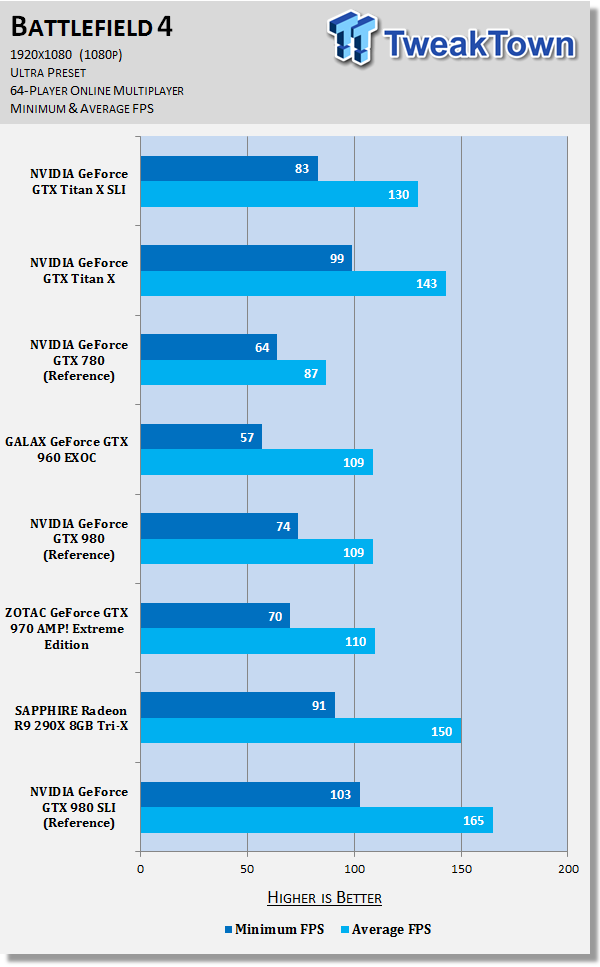
GRID Autosport

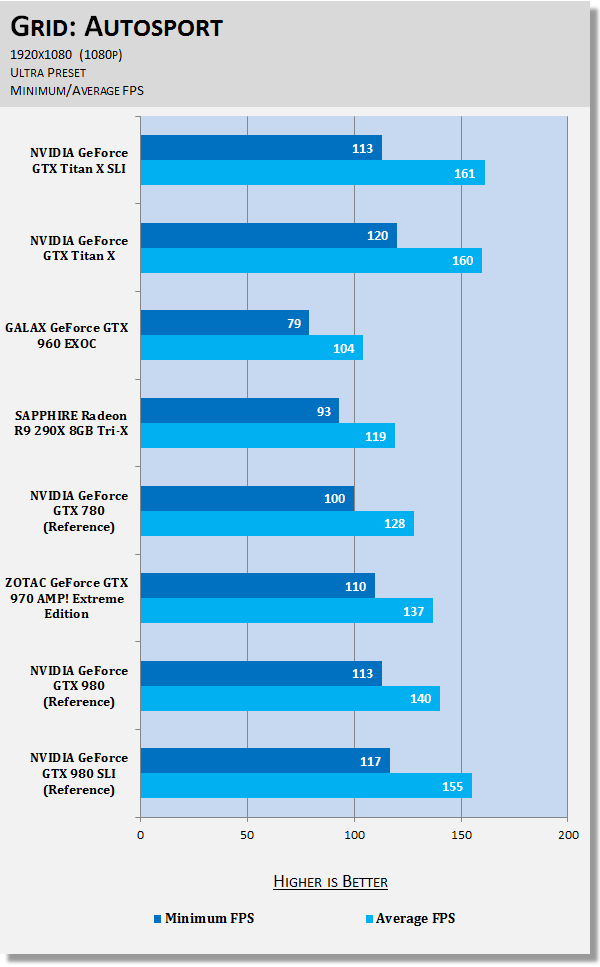
Metro: Last Light

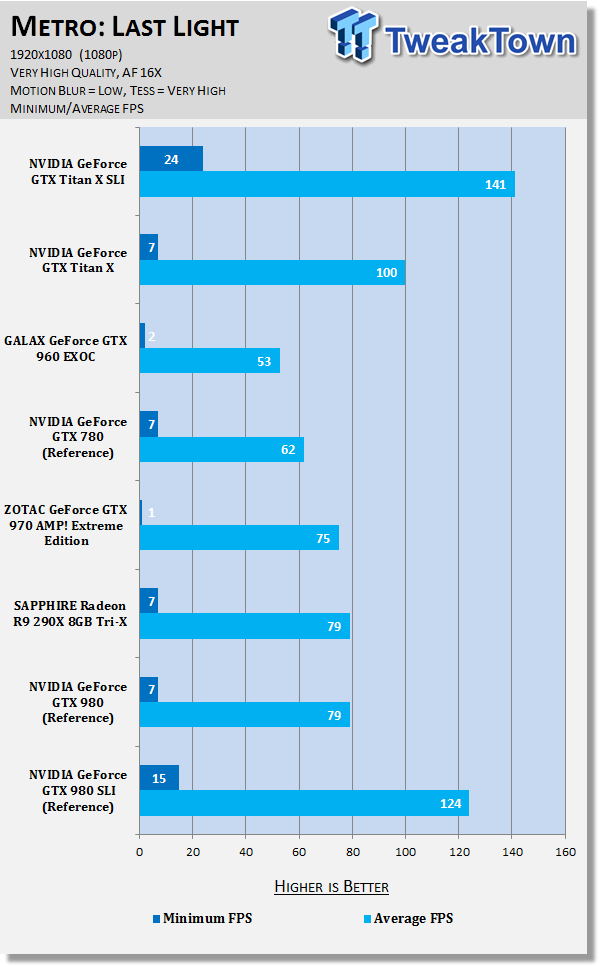
Middle-earth: Shadow of Mordor

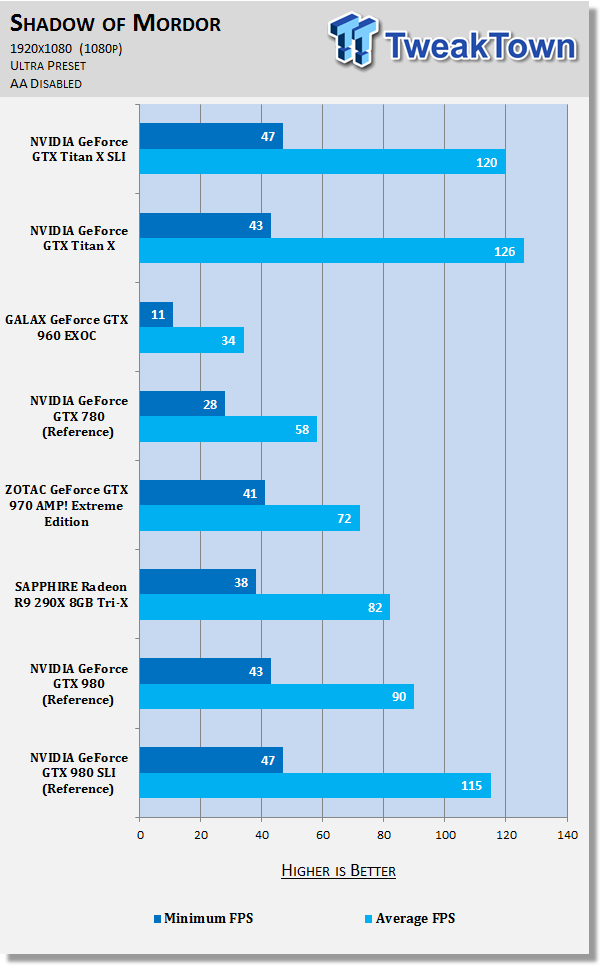
Thief

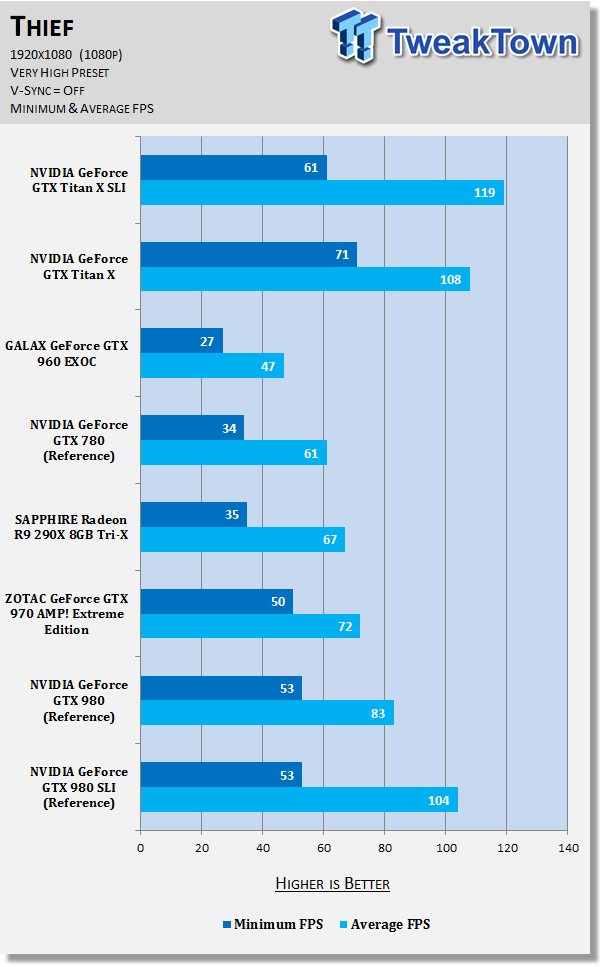
Tomb Raider

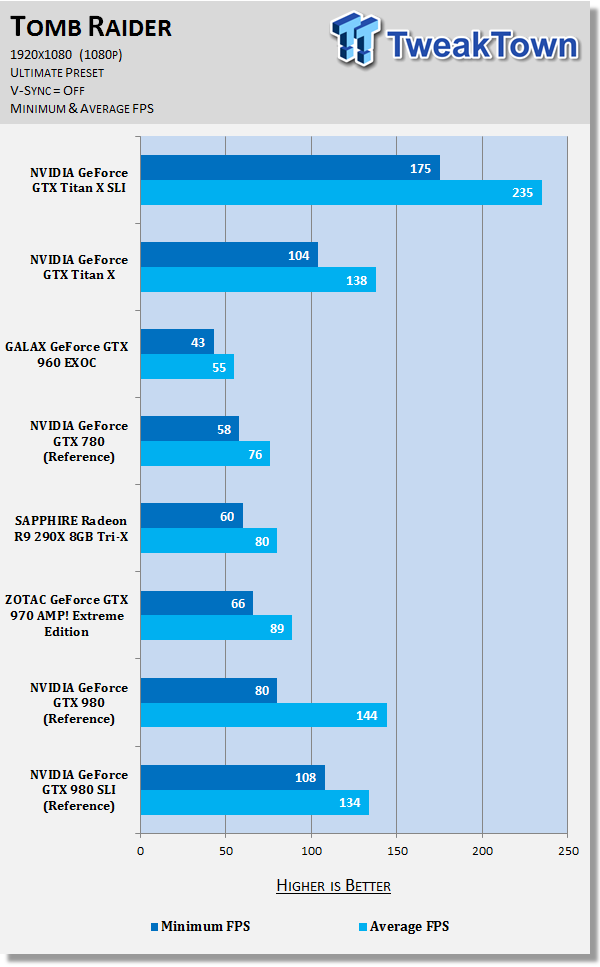
BioShock Infinite

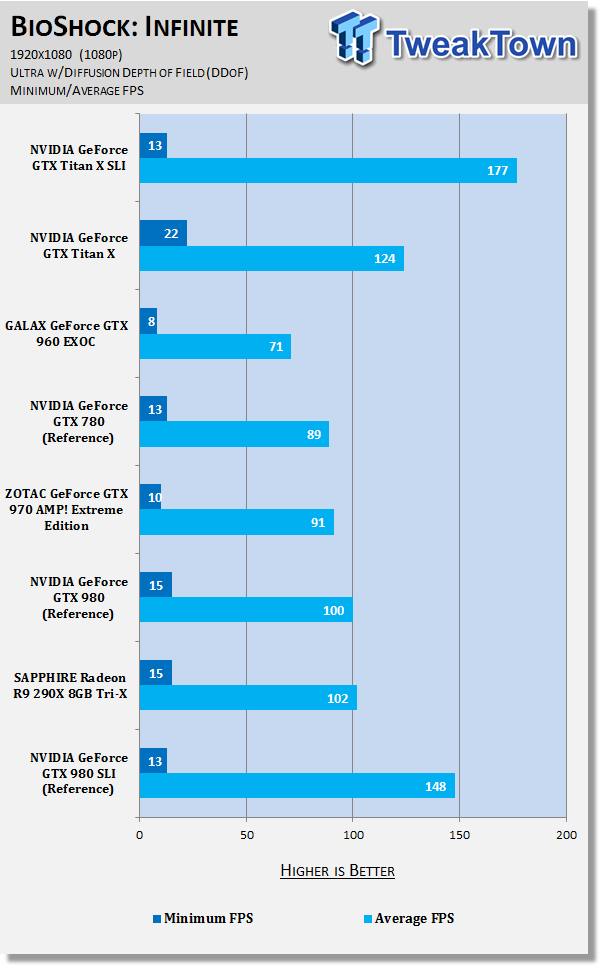
DiRT Showdown

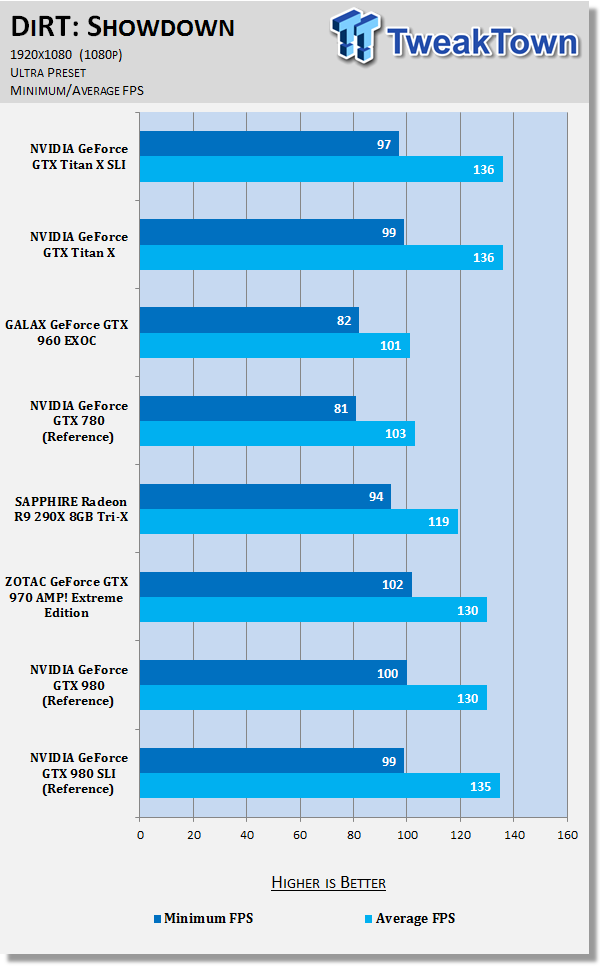
You can find our performance summary of all of our gaming tests later in the review.
Game Benchmarks (1440p)
Battlefield 4

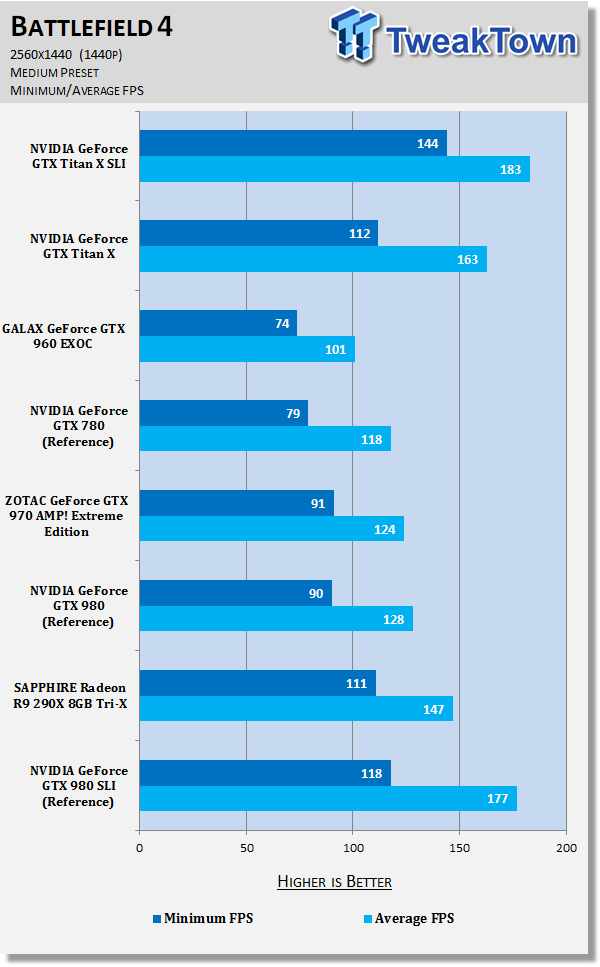
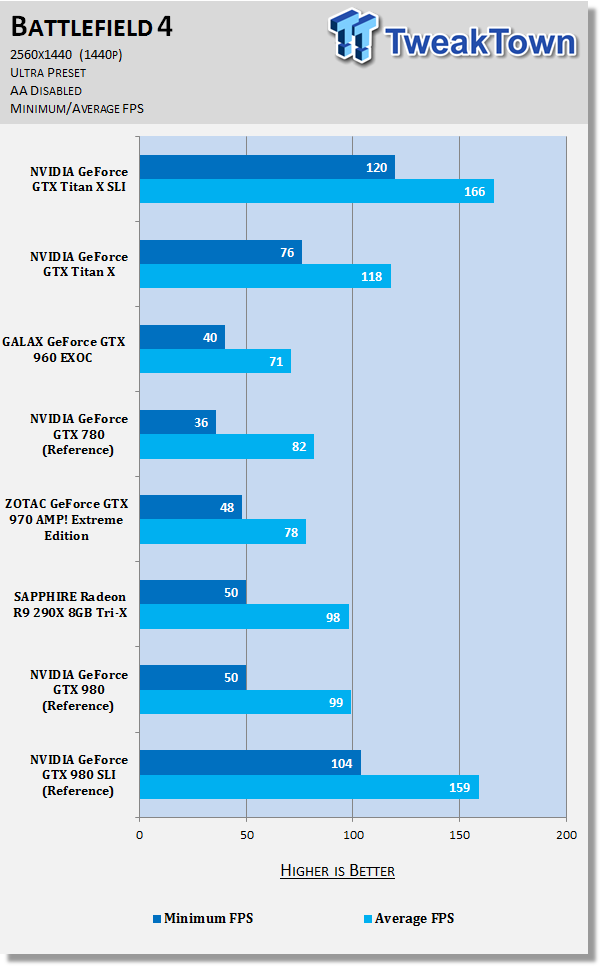
GRID Autosport

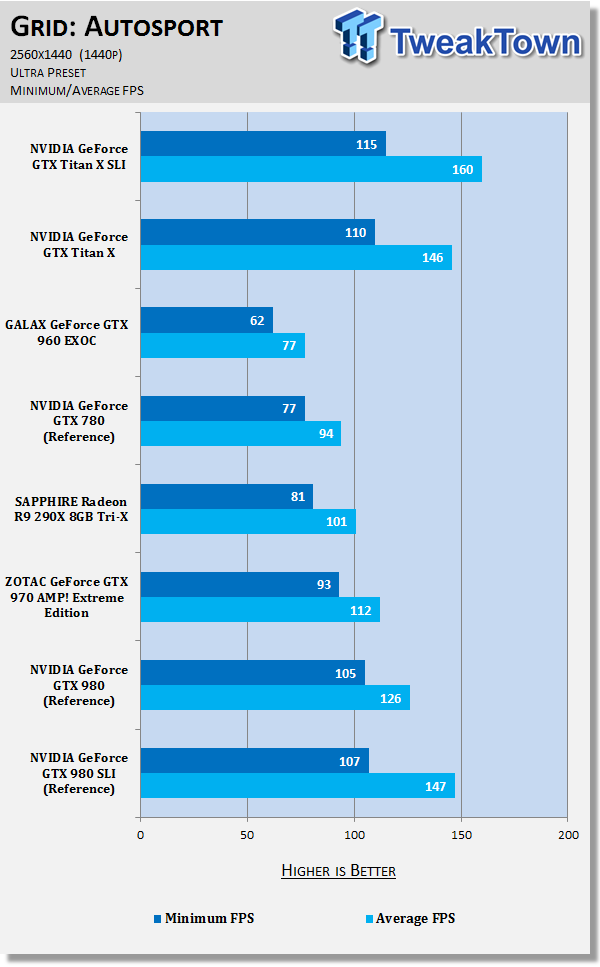
Metro: Last Light

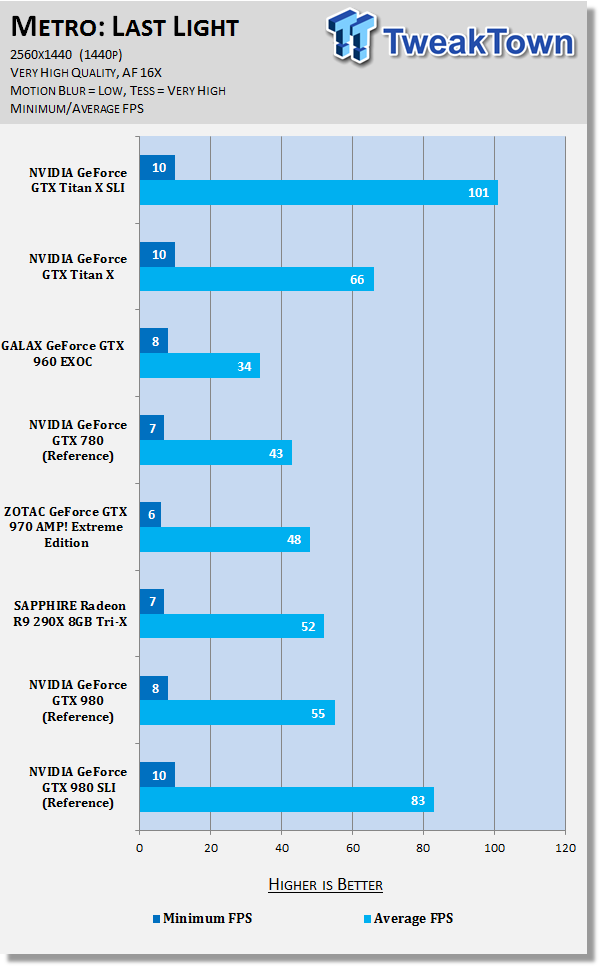
Middle-earth: Shadow of Mordor

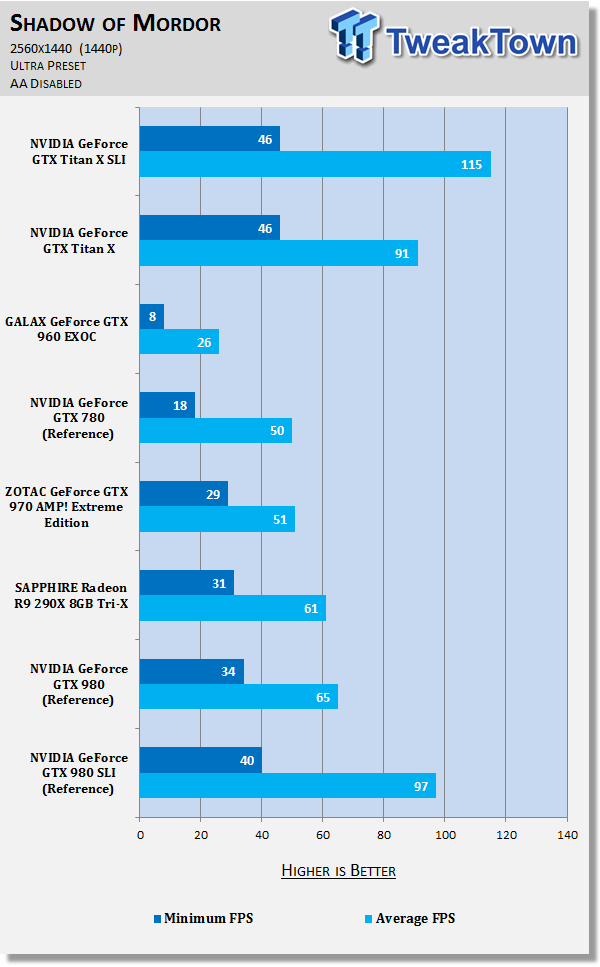
Thief

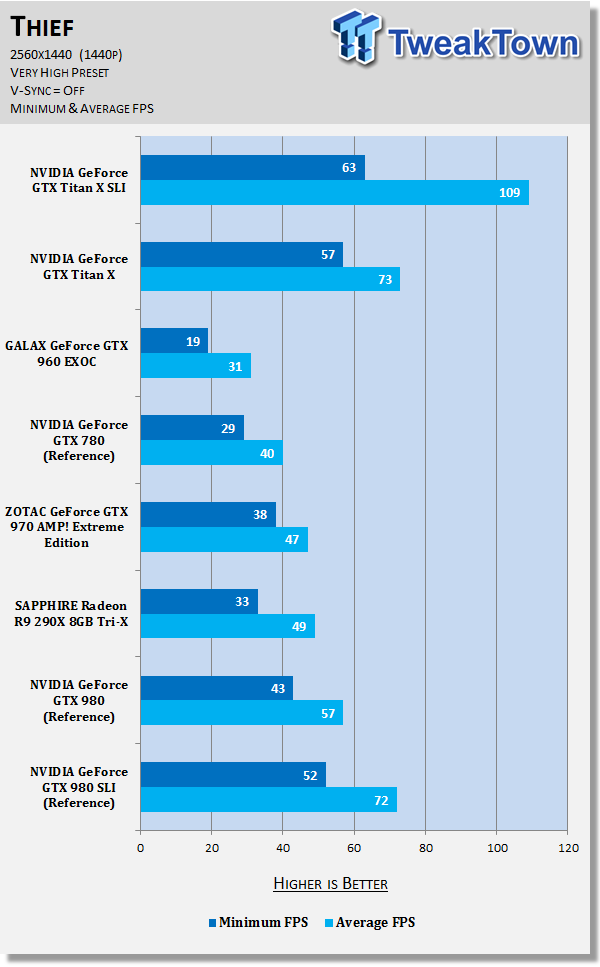
Tomb Raider

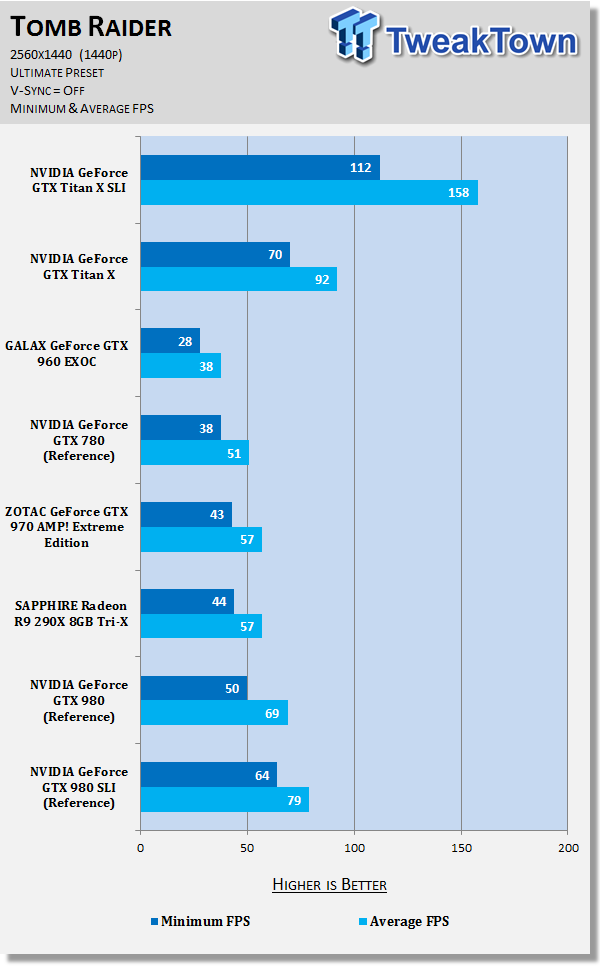
BioShock Infinite

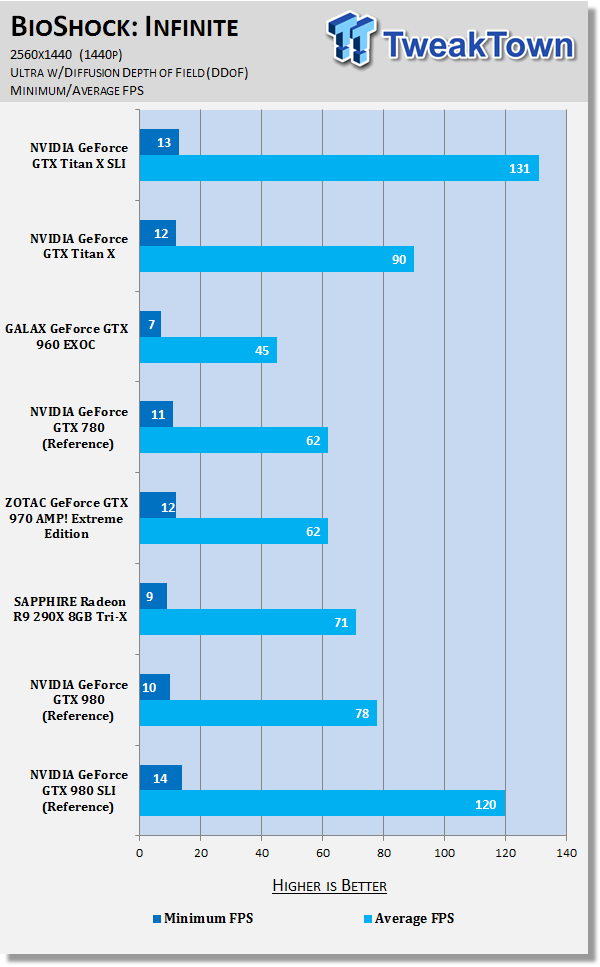
DiRT Showdown

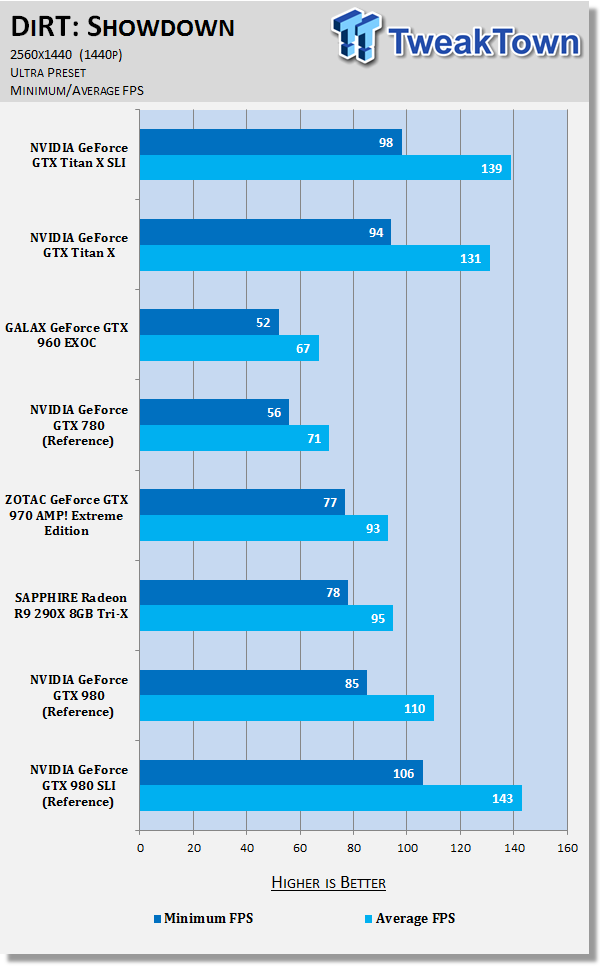
You can find our performance summary of all of our gaming tests later in the review.
Performance - 4K
Battlefield 4

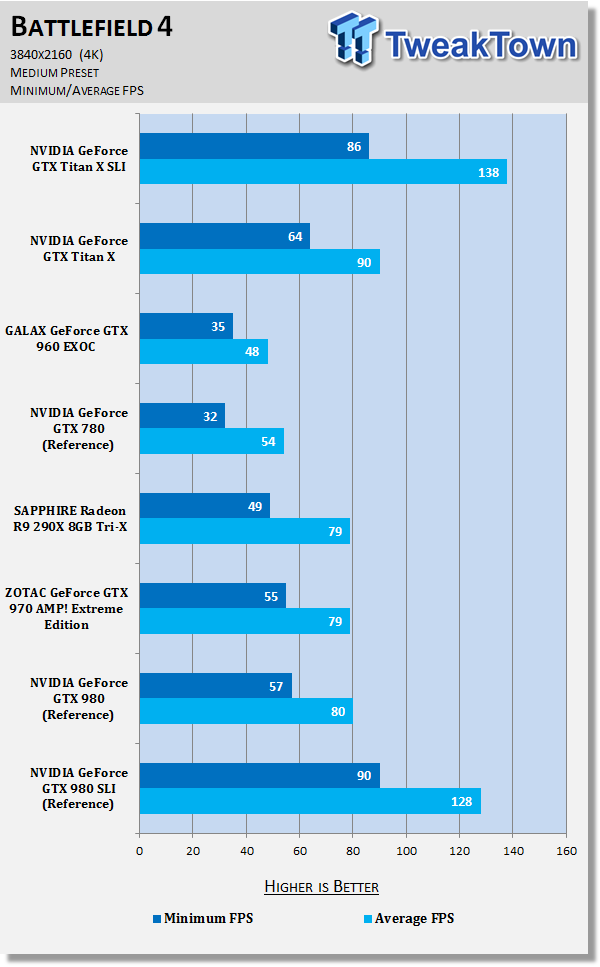

GRID Autosport

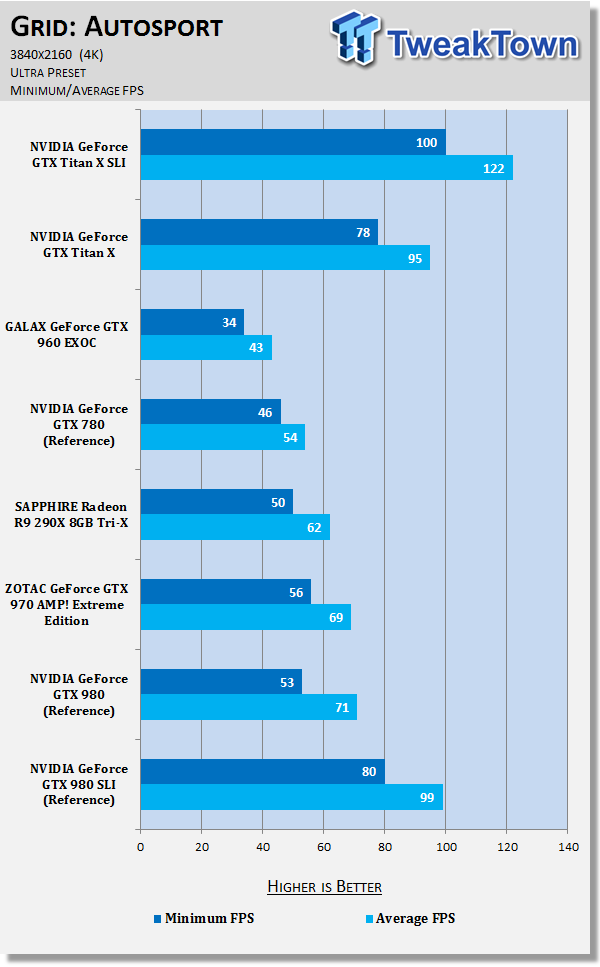
Metro: Last Light

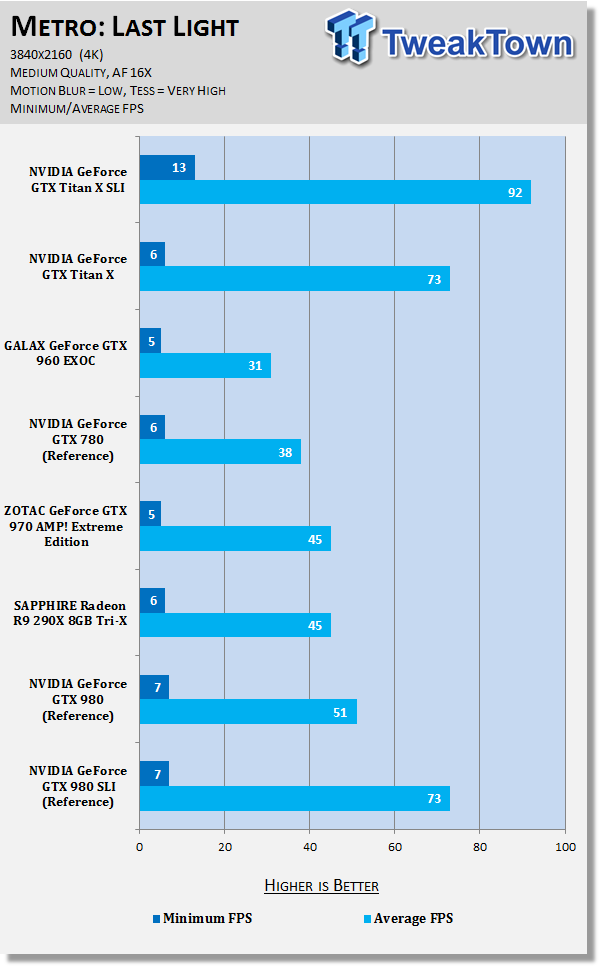
Middle-earth: Shadow of Mordor

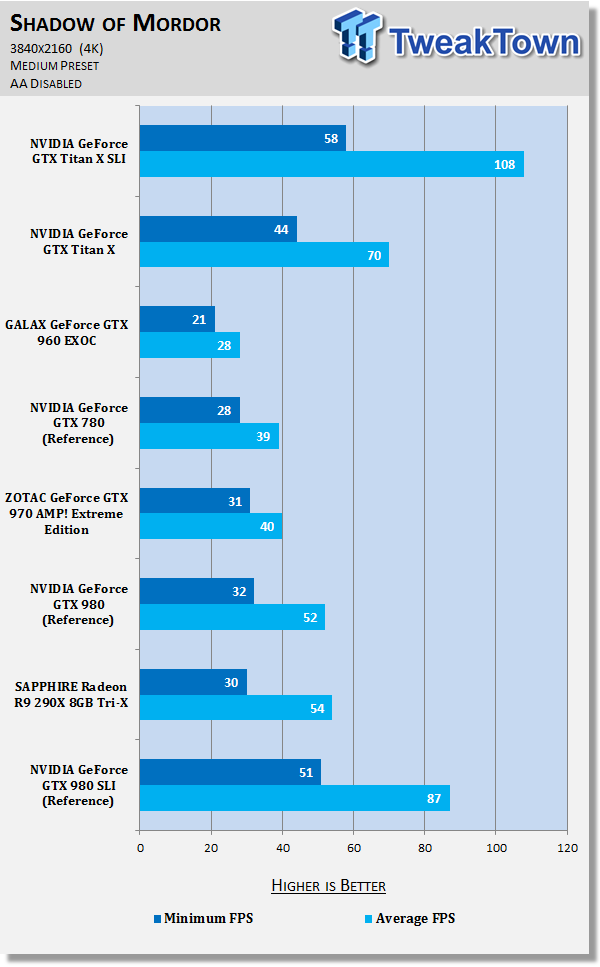
Thief

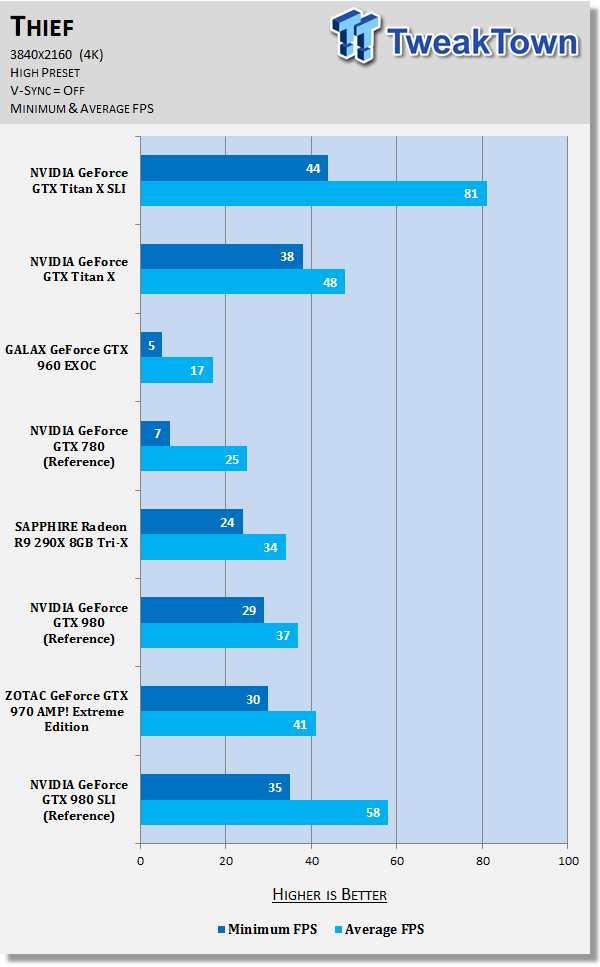
Tomb Raider

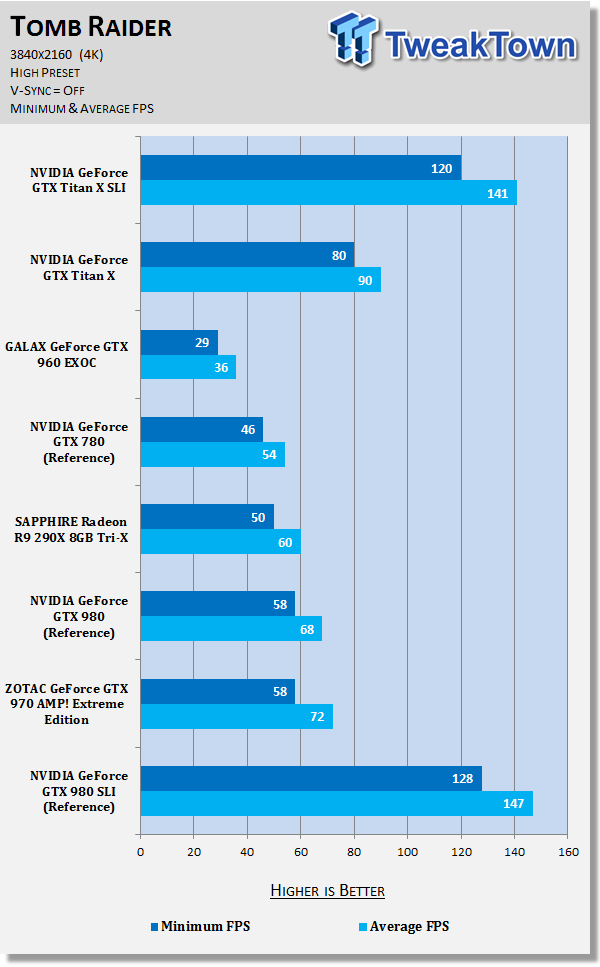
BioShock Infinite

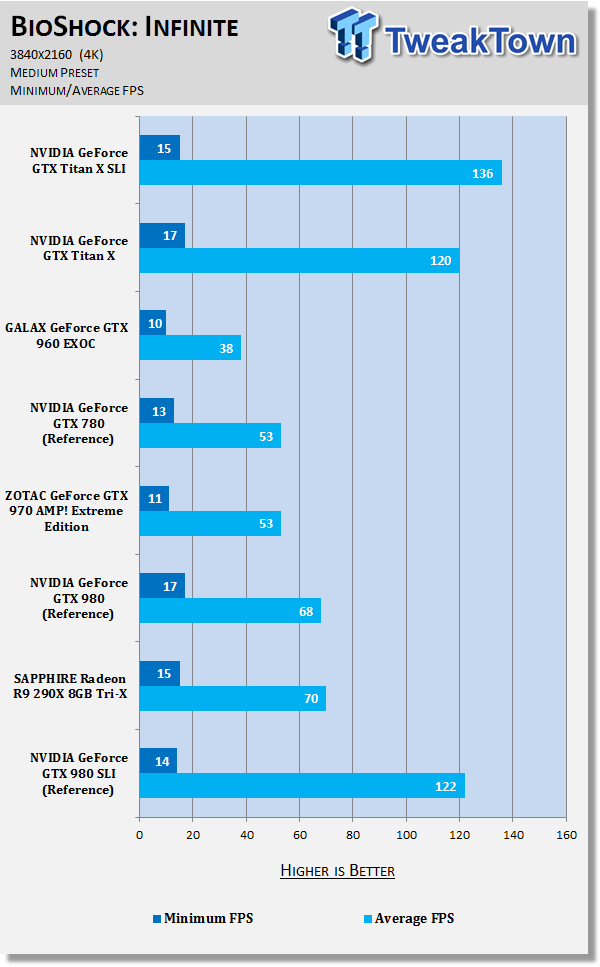
DiRT Showdown

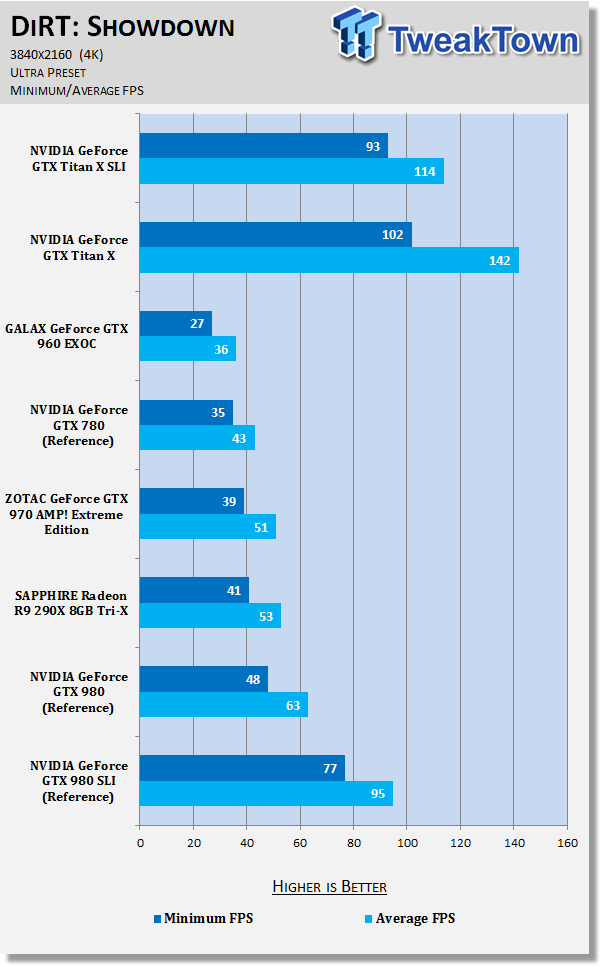
You can find our performance summary of all of our gaming tests later in the review.
Performance Summary
Titan X Times Two = Wow.
As you're about to see below, two GM200-powered GeForce GTX Titan X cards in SLI is something that truly needs to be seen, in order to be believed. We have some absolutely mammoth performance and some great SLI scaling between these cards.
Performance at 1080p
No one is going to buy two Titan X cards and throw them into SLI at 1080p, and as you can see from our Battlefield 4 results, we're maxing out the capabilities of the Frostbite engine itself with a huge 175FPS average on the Medium preset. Turning it up to Ultra, we think premature drivers are seeing a reduction in performance with the cards in SLI - with 13FPS less average performance than the single Titan X.
GRID: Autosport has hit a wall at 160FPS, so the Titan X SLI set up doesn't offer anything at 1080p. But, we're also running $2000 worth of VGA cards at 1080p, which is not the typical scenario. But in saying that, Metro: Last Light has some great scaling with the Titan X in SLI, where we shift up with those minimum frame rates from 7FPS to 24FPS, which is huge. The average FPS also jumps up from 100FPS on the single Titan X to 141FPS on the Titan X in SLI - an improvement of 41%.

Tomb Raider has some massive scaling with the second Titan X, leaping from 138FPS to 235FPS, representing a huge 70% increase in performance. The minimum FPS was also increased by a huge 68%, increasing from 104FPS on the single Titan X to 175FPS minimum on the SLI'd Titan X cards.
Performance at 1440p
We are getting some huge limitation with the Frostbite engine in Battlefield 4 with the two GeForce GTX Titan X's in SLI, where at 1440p and the Medium preset, we're achieving a huge 144FPS minimum and 183FPS average - On the Ultra preset, we see a huge 120FPS minimum and 166FPS average.
We hit the 160FPS wall on GRID: Autosport, even at 1440p with our Titan X's in SLI. Metro: Last Light lathers up the SLI goodness, with a huge 53% performance improvement over the single Titan X with an average of 101FPS, versus the 66FPS on the single Titan X.
Shadow of Mordor has a decent increase of 26% at 1440p, while Thief enjoys a nice 49% improvement thanks to the second GeForce GTX Titan X. Tomb Raider scaling continues its kicking ass from 1080p to 1440p, with an improvement of 71% - increasing from 92FPS average at 1440p, to 158FPS.
Performance at 4K
Amazing performance with the Titan X SLI and Battlefield 4 at 4K, where on the Medium preset we have a huge 138FPS average, beating out the GTX 980 SLI and its 128FPS average. Comparing it to the single Titan X, the Titan X's in SLI are 53% faster for average FPS. The difference between the single Titan X and Titan X's in SLI was also beneficial for the minimum frame rate, which leaps from 64FPS to 86FPS, or 34%.

On our Ultra preset (minus AA) the Titan X SLI is our new star: 119FPS average, a massive 63% improvement on our single Titan X score, and 26% faster than our two GTX 980s in SLI. We're seeing the 384-bit memory bus come into play here, which is great to see. 119FPS average at 4K with Ultra settings is just amazing performance - bring on those 4K 120Hz panels, I say.
This is what we're here for, right? Starting with GRID: Autosport, we're not near the 160FPS wall that we experienced with 1080p and 1440p, but the performance benefit of the second Titan X is apparent. We see an increase of 28%, from the 95FPS on the single Titan X, to the 122FPS on the Titan X SLI.
Metro: Last Light enjoys a 26% increase in performance from the second GM200-powered GPU, while Shadow of Mordor excels with a huge 54% increase in performance thanks to the Titan X SLI. We see Thief with a huge 68% increase in average FPS, while Tomb Raider leaps by 56%.
Power Consumption and Sound Testing
Power Consumption
Power consumption is something that NVIDIA has really dialed in perfectly with its Maxwell architecture, but with two full-blown GM200 cores, do you think that we could see some truly insane performance-per-watt goodness from the Titan X in SLI? Yes, yes we can.
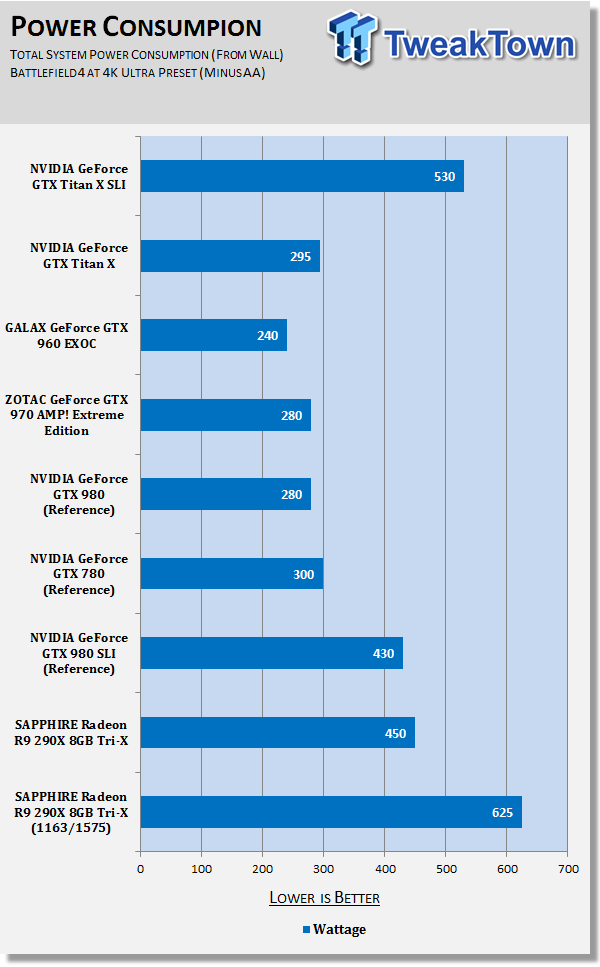
And there you have it: our entire system was drawing just 530W playing Battlefield 4 at 4K. Comparing this to the overclocked AMD Radeon R9 290X that was consuming 450W on its own, or 625W when overclocked, the two GeForce GTX Titan X's in SLI are just an amazing pair of VGA cards.
Sound Testing
We've now got a Digitech QM-1589 that is testing out the sound coming from our VGA cards, with a chart that will slowly be filled.
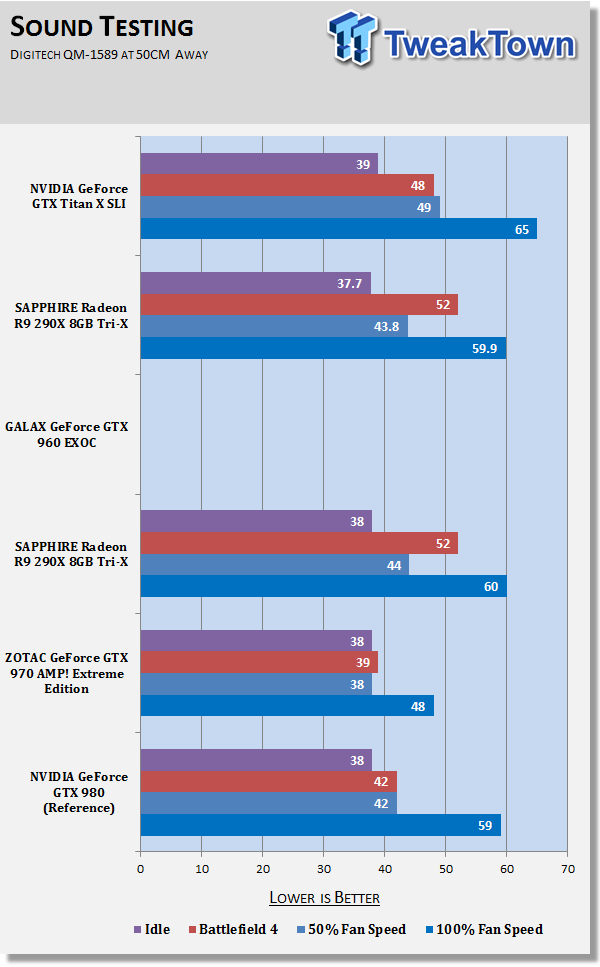
As you can see, the Titan X in SLI can be pretty damn loud when those fans are pumping away at 100%, but during our BF4 usage, they didn't get too loud - pushing out a little less noise than the fans do at a manual 50%.
What's Hot, What's Not & Final Thoughts
This is where you can fast forward to the final section of the review, and get a quick recap and points on the NVIDIA GeForce GTX Titan X in SLI.
What's Hot
Two Really is Better Than One: One GeForce GTX Titan X is already an incredible card on its own, but two of them in SLI is just plain silly. Good silly, of course. We get some incredible performance increases in all of our resolutions: 1080p, 1440p and 4K with the second Titan X.
Incredible Battlefield 4 Performance: We were most surprised with the insane power of the two GeForce GTX Titan X's in SLI in our Battlefield 4 testing at 4K. With 119FPS average, the 4K 120Hz monitors can now come out and there are two VGA cards that you can buy to handle it without a problem: GTX Titan X's in SLI.
Maxwell Efficiency is King: Even with two NVIDIA GeForce GTX Titan X cards in SLI, we're still only consuming under 600W for our entire system.
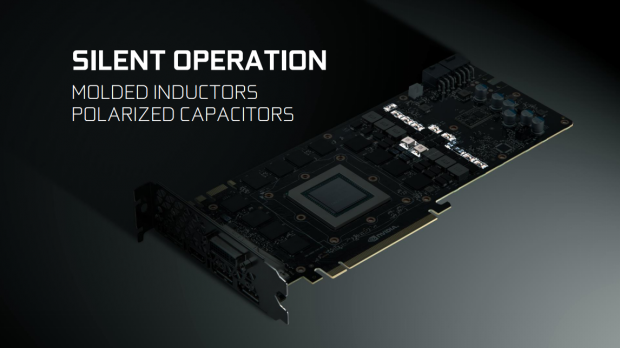
Super Powerful, But Super Quiet: The two Titan X cards in SLI didn't make much noise at all, even under strenuous load. NVIDIA has used molded inductors and polarized capacitors, along with its impressive reference cooler to keep things quiet on the Titan X, even in SLI.
What's Not
Hot to the Touch: Again, the only thing I can really complain about here is that they get a bit warm to touch. However, who is touching their VGA card after a huge gaming session? Not many, I'd say.
Final Thoughts
I loved the single GeForce GTX Titan X, but a second one is just gravy. Pure, blissful, high-performance gravy. But the new GM200-powered Titan X is an interesting beast when in SLI. We have a duo of VGA cards that consume less than 600W for the entire system.
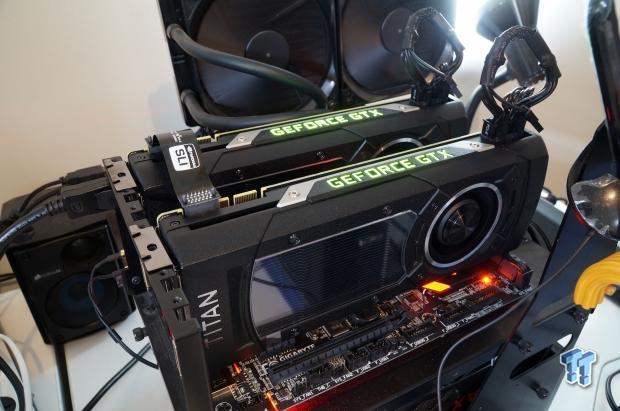
Considering that a single overclocked AMD Radeon R9 290X consumes around 450W, we have some amazing power efficiency from the two Titan X cards in SLI. You could install two Titan X cards into a smaller mATX chassis like the BitFenix Prodigy M and enjoy some serious portable PC power.
The second thing is that even with the reference cooler, the two Titan X cards in SLI do not emit any audible noise whatsoever. I run an open-air test bench, which is not a normal setup for a consumer, and I simply do not hear them. Even while stress testing them at 4K and beyond, the Titan X - and Titan X in SLI - is surprisingly quiet.
Spending $2000 on a pair of VGA cards isn't something you do hastily, but for that money, you're getting a pair of cards that are more than capable of 4K and beyond at 60FPS. The 12GB of framebuffer is going to keep your VRAM heavy games (of which there aren't many - and this is something we'll be following up with in the coming weeks) nice and content.
I'm impressed with the performance a second GTX Titan X provides in SLI even at 1080p, but the benefits are much higher when things are scaled up to 1440p and 4K. At 2560x1440, you're gaming on Ultra detail at 100FPS on average, or more. It's just insane. At 4K, you're ensuring 60FPS and above with the second Titan X, which again, is great.
But those Battlefield 4 results at 4K on the Ultra preset (minus AA) are mind blowing. 119FPS average is simply insane, and is a huge jump on every other VGA card we've reviewed so far. We are now getting to the 4K 120Hz territory with these two cards and that's just awesome.
I ended my original Titan X review with the words "Your move, AMD" and I'll repeat those again: Your move, AMD.


 United
States: Find other tech and computer products like this
over at
United
States: Find other tech and computer products like this
over at  United
Kingdom: Find other tech and computer products like this
over at
United
Kingdom: Find other tech and computer products like this
over at  Australia:
Find other tech and computer products like this over at
Australia:
Find other tech and computer products like this over at  Canada:
Find other tech and computer products like this over at
Canada:
Find other tech and computer products like this over at  Deutschland:
Finde andere Technik- und Computerprodukte wie dieses auf
Deutschland:
Finde andere Technik- und Computerprodukte wie dieses auf